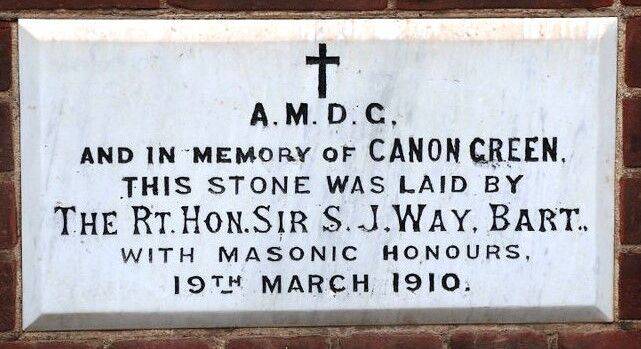
Canon Samuel GreenPrint Page 

The St Paul`s Parish Hall was erected to commemorate Canon Samuel Green (1841 - 1904). The foundation stone of the hall was laid on the 19th March 1910 and the hall was officially opened on the 20th July 1910.
Samuel Green was born in February 1841 at Uppingham, Rutland, England, the son of the Reverend John Green, a Dissenting clergyman, and his wife Martha Margaret. His early ambition was to join the East India Civil Service. In 1863 he won a high place among applicants but changed his mind and went instead to South Australia and offered himself for the Anglican ministry. Trained by Bishop Augustus Short, he was ordained in 1865. As parish priest he worked mainly at Port Adelaide in 1865-66 and 1868 to 1893 and in Glenelg from 1893 to 1904.
One of the first High Churchmen in a strongly Evangelical colony, Green asserted the catholicity of the Church of England and introduced such innovations as weekly celebrations of Holy Communion and choral Eucharists, with the so-called 'ritualistic devices' of processional cross, altar candlesticks and incense.
In 1869 a petition against ritualism was circulated through the diocese by militant Evangelical laymen who urged synod to remove Green and three other clergy from the diocese. The Synod refused almost unanimously to debate the motion. Bishop Short investigated complaints about Green's services and concluded that 'not a hint had been breathed of false doctrine' by the priest. His sincerity and tact won over his congregation and most laymen in the diocese. He was appointed clerical secretary of synod in 1870 and served on the standing committee for thirty-five years.
Green also promoted the revival of spiritual discipline, conducting Lenten observance and retreats. He was closely connected with the Confraternity of the Blessed Sacrament and with early work of the Kilburn Sisterhood. As canon missioner of the diocese from 1896 to 1904 he conducted parish missions designed to strengthen the life of the Church. He was also keenly aware of social problems, and was an supporter of local institutes and was connected with the Port Adelaide Workingmen's Association, founded in 1872 and the Homestead League, formed by George Cotton in 1885.
Green decided to stand as a candidate for Port Adelaide in 1878 in protest against the constitutional exclusion of ministers from parliament. Backed by local clergy, he had an enthusiastic response when 800 port electors attended a meeting to hear him and declare him a fit candidate. Proclaiming his principle vindicated, he stepped down before polling day.
Green actively supported co-operation between capital and labour. In the 1887 shipping stoppage at Port Adelaide he addressed 3000 strikers, urging them to return to work. In the maritime strike of 1890 he told a large meeting that 'men were striking for their corporate existence - for unionism, by which they had managed to raise their lives. The owners had not a stake like that to fight for'. He also urged employers to initiate a permanent board of conciliation.
A popular speaker, Green gave many public lectures, often using lantern slides. He also ran a Spiritualist circle, with his wife as 'an effective Planchette medium', at the Port Adelaide Institute in 1880 - 81.
Janet Scarfe, Australian Dictionary of Biography
Location
| Address: | Church Place, St Paul`s Parish Hall, Port Adelaide, 5015 |
|---|---|
| State: | SA |
| Area: | AUS |
| GPS Coordinates: | Lat: -34.845509 Long: 138.502726 Note: GPS Coordinates are approximate. |
Details
| Monument Type: | Structure |
|---|---|
| Monument Theme: | People |
| Sub-Theme: | Religion |
Dedication
| Actual Monument Dedication Date: | Saturday 19th March, 1910 |
|---|
A. M. D. G.
And in memory of Canon Green.
This stone was laid by the Rt. Hon. Sir S. J. Way, Bart., with Masonic honours.
19th March 1910.


 Hall Foundation Stone March 1910
Hall Foundation Stone March 1910
